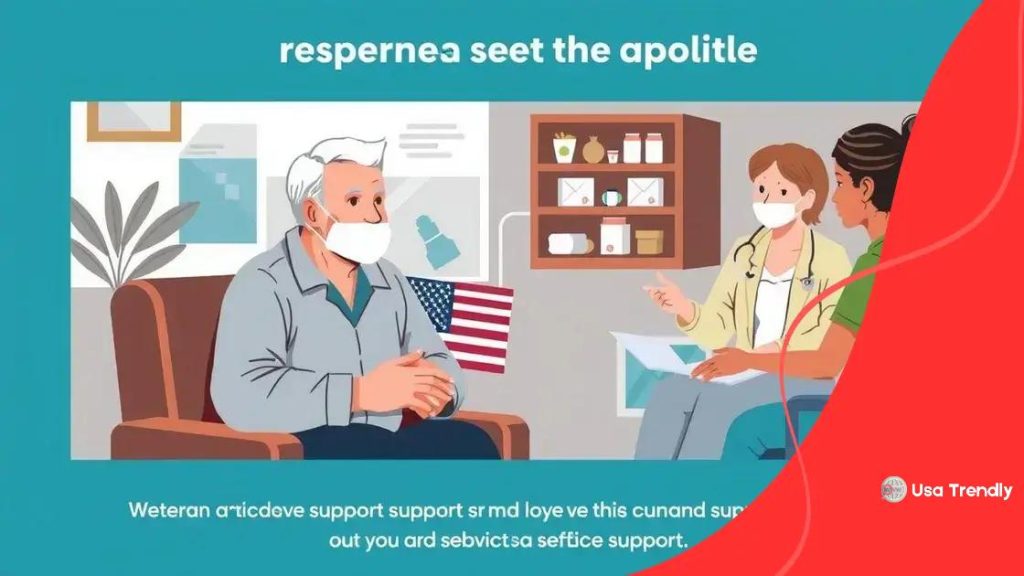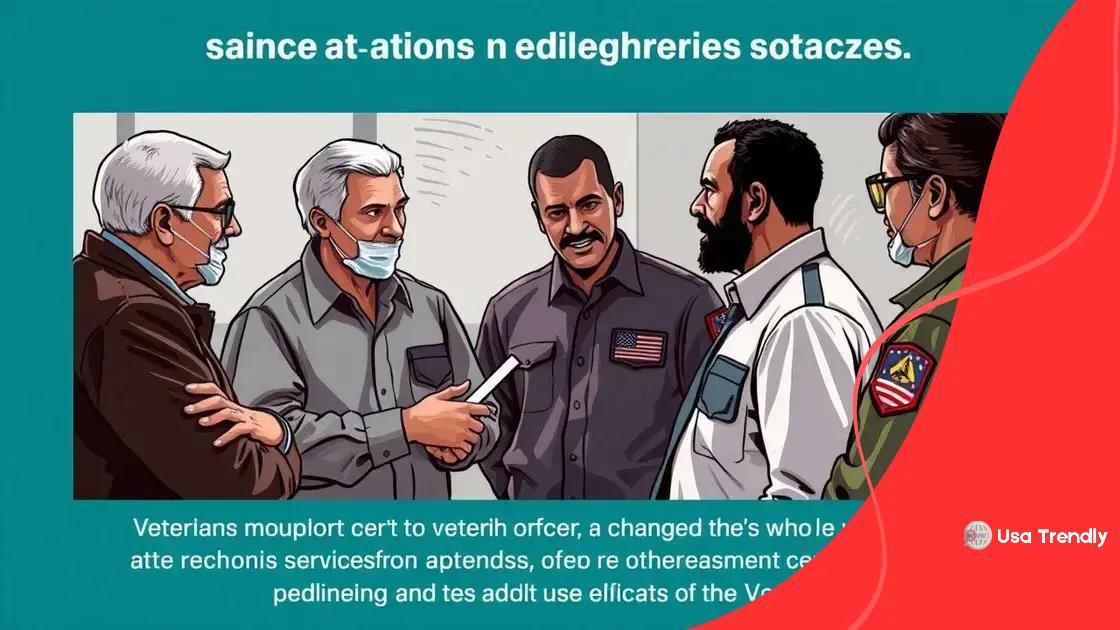New reforms target veterans’ services: what you need to know

New reforms target veterans’ services by providing enhanced healthcare access, educational opportunities, and mental health support, addressing key needs of veterans effectively.
New reforms target veterans’ services, bringing changes that aim to better support those who served. Curious about what these reforms mean for you or your loved ones? Let’s dive in.
Overview of the new reforms
The overview of the new reforms showcases significant changes aimed at enhancing veterans’ services. These reforms promise to improve accessibility and ensure better support for those who have served our country.
Key Features of the Reforms
One important feature is the expansion of mental health services. Many veterans face challenges after their service, and these new measures aim to provide necessary resources.
- Increased funding for counseling
- 24/7 crisis helplines
- Telehealth options for remote support
Additionally, the reforms focus on educational benefits for veterans. Education is vital for preparing veterans for civilian life and careers. Loans and grants will now be more accessible, making it easier for veterans to pursue their educational goals.
Streamlined Processes
Another aspect of these reforms is the effort to simplify application processes. Veterans often report frustration with long waits and complicated paperwork. With these new systems, applications will be faster and more straightforward.
- Online application systems
- Dedicated support representatives
- Clear guidelines for eligibility
Ultimately, the new reforms are designed to create a more supportive environment for veterans. By addressing mental health, education, and administrative hurdles, these changes aim to improve the overall quality of life for those who served. It’s an encouraging step forward in recognizing and meeting the needs of our veterans.
Key benefits for veterans
The key benefits for veterans in the new reforms are designed to enhance their lives significantly. These benefits focus on essential areas such as healthcare, education, and financial support.
Improved Healthcare Access
One of the most critical aspects of the reforms is improved access to healthcare. Veterans are now able to receive timely medical attention, which is crucial for their physical and mental well-being. A robust healthcare system ensures that veterans can address health issues more efficiently.
- Enhanced mental health services
- Faster processing of health claims
- Greater availability of specialists
Moreover, veterans will experience a more streamlined system for healthcare access. This includes easier navigation of services and a more responsive network that addresses their needs directly.
Educational Opportunities
Education is another significant benefit. The reforms provide expanded opportunities for veterans to pursue higher education and vocational training. This support is vital for helping veterans transition smoothly into civilian careers.
- Increased financial aid for schooling
- Access to job training programs
- Tuition assistance for degrees and certifications
This commitment to education helps veterans gain the skills they need to succeed in the job market. By focusing on learning, these reforms aim to empower veterans for productive lives.
Additionally, financial support has been improved dramatically. Veterans will see more accessible housing loans and benefits that can ease their transition back into civilian life. This security is essential as it lays a foundation for their success in society.
Overall, the key benefits for veterans provided by the new reforms are a significant step in acknowledging their sacrifices and ensuring they receive the support they deserve. From healthcare access to educational assistance, these changes aim to foster a better quality of life for our veterans.
Challenges faced in implementation

The challenges faced in implementation of the new veterans’ services reforms are significant. While the intent of the reforms is clear, the actual execution encounters several hurdles that can affect their effectiveness.
Funding Limitations
One of the primary challenges is securing adequate funding. While the government has promised financial support, budget constraints often hinder the full rollout of services. This limitation can slow down necessary improvements and affect the quality of support available to veterans.
- Allocation of resources
- Delays in funding release
- Managing competing budget priorities
As reforms aim to expand access to services, any delay in funding can pose a significant barrier to implementation.
Data Integration Issues
Another challenge revolves around data integration. Veterans’ services require coordination between various government agencies. Lack of efficient systems can lead to miscommunication and information silos, ultimately affecting service delivery.
- Inconsistent data systems
- Difficulties in inter-agency communication
- Slow updates to technology
Such data issues can result in veterans experiencing delays when seeking support, which is frustrating for those who need help urgently.
Moreover, training staff to understand and navigate new systems can be complex. Many veterans’ service representatives must familiarize themselves with updated protocols, which can take time and affect the overall experience for veterans seeking assistance.
Additionally, raising awareness about these new services among veterans is crucial. Many may not know the reforms exist or how to access available benefits. Effective outreach strategies are needed to ensure veterans are informed and can utilize the resources meant to help them.
In summary, while the new reforms aim to improve veterans’ services, the challenges faced in implementation can impact their effectiveness. Addressing funding, data integration, staff training, and outreach will be essential to fully realize the benefits these reforms promise for veterans.
How to access the new services
Accessing the new services provided by the veterans’ reforms is designed to be straightforward and user-friendly. Veterans and their families can take advantage of these services with a few easy steps.
Online Access
First, many services are available online. Veterans can visit the official government website dedicated to veterans’ affairs. There, they can create an account to manage their benefits, apply for education assistance, and schedule healthcare appointments.
- Visit the veterans’ affairs website
- Create a personalized account
- Explore available services and benefits
This online access not only saves time but also provides a wealth of information at the veterans’ fingertips.
In-Person Assistance
For those who prefer face-to-face interactions, local veterans’ centers are available. Veterans can visit these centers to consult with representatives who can guide them through the services.
- Find your nearest veterans’ center
- Prepare necessary documentation
- Schedule an appointment if needed
These in-person visits can provide personalized assistance tailored to individual needs, making it easier to understand which services are most beneficial.
Additionally, many community organizations partner with veterans’ affairs to provide outreach programs. These programs often host workshops that educate veterans on how to access services and benefits effectively.
Engaging with these community resources can further enhance the experience of accessing new services. Veterans should also stay informed through newsletters and social media channels from veterans’ organizations.
Overall, accessing the new services is manageable through both online platforms and local resources. With the right approach, veterans can effectively utilize the benefits meant to support them in their post-service lives.
Success stories from veterans
Success stories from veterans illustrate the positive impact of the new reforms in providing essential support. These stories highlight how veterans have effectively utilized the services offered to improve their lives.
Finding Fulfillment Through Education
A common theme in many success stories is the pursuit of education. For instance, a veteran named Mike returned to school and completed his degree thanks to increased educational benefits. With the financial support provided, he was able to attend a local university, gain new skills, and eventually land a job in his desired field.
- Mike’s story shows the power of educational assistance.
- Many veterans are now enrolling in vocational training programs.
- Access to scholarships has made education more affordable.
These educational success stories inspire others to take similar paths and realize their potential.
Support for Mental Health
Another vital area where veterans have found success is in mental health support. Sarah, a former service member, utilized the expanded mental health services to cope with challenges after leaving the military. The access to counseling and support groups helped her tremendously.
- Sarah reports a significant improvement in her mental well-being.
- Many veterans are sharing stories about overcoming challenges.
- Access to therapy has led to better coping mechanisms.
Her experience underscores how enhanced mental health resources are truly making a difference in veterans’ lives.
These success stories serve as powerful reminders of the positive outcomes achieved through the reforms. Veterans across the country are finding new purpose and avenues for growth, whether it’s through education, health support, or community engagement. By celebrating these stories, we acknowledge the resilience and determination of those who have served.
The reforms targeting veterans’ services represent a significant step forward in supporting those who served our country. From improved healthcare and educational opportunities to better mental health resources, many veterans have begun to see meaningful changes in their lives. Success stories highlight how these services are making a real difference, empowering veterans to thrive in their post-military journey. It’s crucial to continue raising awareness about available resources and to address any challenges in implementation to ensure that every veteran can access the help they need. Together, we can build a community that honors and supports our veterans every day.
FAQ – Frequently Asked Questions about Veterans’ Services Reforms
What services do the new reforms provide for veterans?
The new reforms provide improved healthcare access, educational assistance, mental health support, and streamlined application processes for veterans.
How can veterans access these new services?
Veterans can access services online through the official veterans’ affairs website or by visiting local veterans’ centers for in-person assistance.
What challenges are faced in implementing these reforms?
Challenges include funding limitations, data integration issues, and the need for effective outreach to ensure veterans know about the services available.
Can you share examples of success stories from veterans?
Many veterans have successfully pursued education and improved their mental health through the expanded services, demonstrating the positive impact of the reforms.
SEE MORE CONTENT